October 2 - 8, 2016: Issue 283
David Whiteman
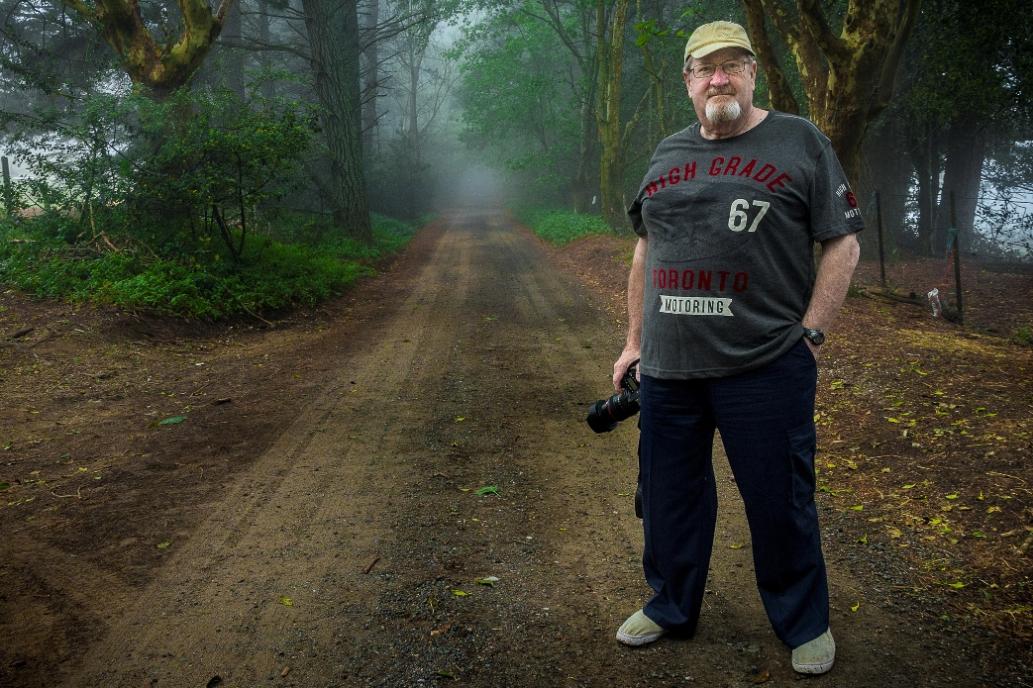
Dave Whiteman is a gentleman of infinite talents who shows you may more than adapt to changing circumstances and live your life to suit your passions. Versatile to the nth degree, advances in services may be attributed to his hard work, an insight into Newport during an era when so much was changing and a love for this area still inherent dwell within his self and spirit.
We first noticed Dave's photographic talents when one of his great images of Palm Beach Camping area from the mid 1950's popped up in the Old Sydney Album on facebook, just one of the places we have a look when researching for History pages. After a quick conversation with Dave, and he happily allowing us to run this photo on the Front Page - Issue 265 in that base spot we reserve for Environment each week, present, and occasionally past, we knew we had to talk for a longer spell to him.
One of the first things he wanted us to get out to all of you was an upcoming Pittwater High School Reunion for all of you there during the first decade of this great local school - details:
Pittwater High School – Years 1963 to 1972 Reunion
October 22nd 2016 at 12 noon. Royal Motor Yacht Club, Newport.
Students who attended Pittwater High School between 1963 and 1973. The Facebook group is for students who were at the school at the same time as the first group of students who graduated in 1968, and graduating no later than 1973. https://www.facebook.com/groups/phsey/
Further information … email Dave Whiteman at snowy.whiteman@gmail.com
Then we went on to talk about Visions - and photography being able to communicate these - logical conclusion: ask Dave to take a turn as an Artist of the Month - which he is for the whole of October. Soon he began speaking about Newport, the place where he grew up, and thankfully allowed us to start at the beginning to make a record of one who was there, then:
Where and when were you born?
1951 in the old Mater hospital at St. Leonards. At that stage we lived at North Ryde, which was the outer suburbs of Sydney.
How long did you spend at North Ryde?
We were there until I was about 6 when we moved to Newport Beach in 1956/1957 to 6 The Boulevarde.
What was it like growing up in Newport during the 1950’s?
Newport was like an appendix of Sydney and the world ended at the Eleven Mile Store, south of there was a big black hole to us kids. Newport, and the peninsula further north was really like a backwater, like the country or a rural area. Seeing the old double decker 190 bus going through was the only link you had with the city.
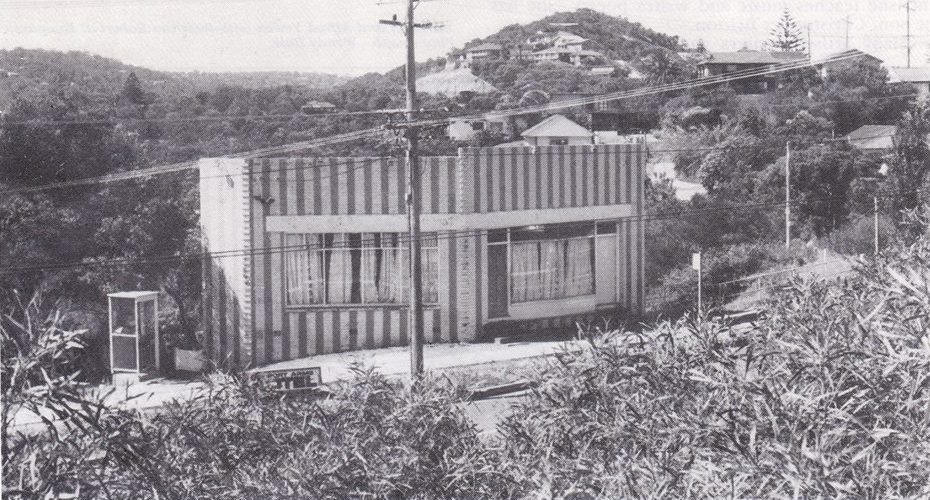
Reconstructed Eleven Mile Store (Porters Store) - courtesy Guy Jenning's The Newport Story 1788 - 1988
Newport in the 50’s was more of a holiday resort – lots of cottages and people who had holiday houses. It was a village with weekenders and had that village feel about it. There were some old buildings and where the Ampol service station used to be on the corner of the Boulevarde and Barrenjoey Road, opposite the bowling club, there was a Chinese restaurant, the only one in town. As kids we’d walk past and the putrid smell was overpowering.
Opposite that there was an old Art Deco style house called ‘The Lodge’ which was an abandoned building. In those times that’s where some of the local lads used to take some of the local girls. Very risqué!
Just along from there was Buck Taylor’s grocery store and the main shopping centre was down the Northern end of the town. Dave Pitt’s newsagency was on the eastern side before it crossed the road, the Hodges had a hardware store and Bert Payne had the Timber yard at the back of this. Old Tom Wilson worked at the hardware store. His claim to fame was that the character Tug Wilson in the R E MacDonald novels about the Australian Navy in the Second World War, was based on him. Tom Wilson was quite a character, he used to come to work in a bow-tie – you could buy anything in that hardware store. Up the little lane beside the hardware store there was a Pet shop where I bought my birds.
There was the Alley Cat Milk Bar where the Beatniks used to hang out and down on the corner of Coles Parade was Bolle’s Milk Bar where the surfers used to hang out and opposite that, Spellson’s Night Club. Opposite was the Box-O-Birds milk bar and Tingell’s Nursery.
Newport was pretty Bohemian in those days and attracted some very interesting characters. Not many will remember “The Dugout” off Bromley Lane next to the bootmakers. On a Saturday night the Beatniks would meet there in a smoke filled room with the beat of hip music thumping.
There was nothing at what is now Porters Reserve, it had been a tip in those days. My dear old dad would take rubbish to the Newport and Avalon tips before they closed and this was considered a day out for us kids as he’d not only take rubbish to the tip, he would return with more than he went with. We would go could scavenging and we’d be running around in thongs, not even thinking about bits of wood with nails or anything like that. Meanwhile dad would look for pieces of cedarwood to use in his woodwork projects.
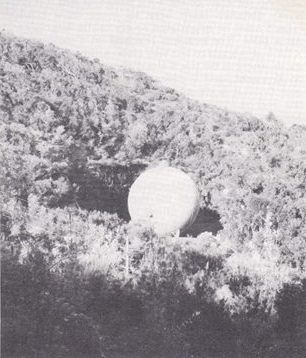 Many people remember old Mary who ran the Avalon tip we wondered how rich she may be. Newport tip closed when they filled it and they built a gas ball up and the end of the track and water tanks up top above Attunga Road.
Many people remember old Mary who ran the Avalon tip we wondered how rich she may be. Newport tip closed when they filled it and they built a gas ball up and the end of the track and water tanks up top above Attunga Road. Liz and I met at the St Michael’s Newport Church Fellowship Group. I used to go there because it was somewhere to go on a Friday night, to get out of the house. Liz was 12 when I met her and I was 16 and we’re still together. Anyway, Liz and I would wander up to the gas ball in Spring and pick the wild Freesias, they were all around there then. Porters Reserve was named for Carl Porter who was the boss of a construction company. I went to school with one of his sons, Robbie.
The gas ball reservoir in what used to be called 'Farrell's Quarry' - courtesy Guy Jenning's The Newport Story 1788 - 1988
At Newport Public school. Mr. Embury was the headmaster then and David Embury, his son, was in my class. Miss Bird was headmistress of the Primary section. I started there in Transition Class, which was in-between Kindergarten and First class.
I didn’t know Liz then though, she was living in Wallumatta road. To show you how keen I was, I used to ride my bike around to there and then walk up that hill, that’s a big hill.
One day I was coming back, when I was about 17, and Liz’s mum was taking them out somewhere in her little Volkswagen. We got down the bottom of the hill, me on my bike, near Heath Howell’s garage and they stopped at Barrenjoey Road and I kept going, straight into the back of her car. I used to build up some speed coming back down that hill.
Tim Bristow was also around when I was growing up. If I was down surfing he would come down, he was living in the units at the end of Ross Street prior to building a house round in The Crescent. If he saw me he’d drag his surf ski down and call out for me to come paddle his surf ski for him. I’d put my board down and paddle his ski off out off Newport Reef while he was snorkeling and spear diving. He’d spear fish and put them into a bag and I had to try and keep this bag on the surf ski, which would keep washing off and they’d be bloody sharks all around us – he was mad that bloke!
Liz’s father John Parkes, nicknamed ‘Cyprus Sid’, was in the Police as well and was a mate of Tim’s. He went to Cyprus with the NSW Police contingent as part of the United Nations Peace Keeping Force in the late 1960’s. This was a 12 month stint and you had to be a Senior Constable or above for them to take you.
Tim kept an eye on Liz’s family while her dad was away. Liz actually had her 21st at Tim’s home in The Crescent. This was a good night until some shady characters suddenly arrived and Tim said ‘everybody leave’ – and that was it, we all had to go.
I remember one Friday night, I’d had an altercation with one of the Windshuttle boys the previous week. They sent a deputation around to the church Fellowship hall and said ‘we’ll see you down at the Surf Club after this is done.’ I thought ‘righto, it’s going to be on’ I went down there and there was around a hundred guys gathered and we were shaping up ready to get stuck into it and all of a sudden there’s this thundering voice; “What the duck’s going on here?!” It was Tim. “I know both of your old men and they’ll be very upset if they find out this is going on.” The fight never got going after that– Tim was like that.
Where did you go to High School?
Pittwater High, I was in the second year to go there in 1964. The school opened in 1963, prior to that the only High School in the area was at Narrabeen. Stan Gorrell was the headmaster when I went through Pittwater. He was a tough old buzzard with the nickname ‘Stag’. Pittwater High school was good, a great school. This was during the 1960’s and there were a lot of things going on, the Vietnam War for instance.
At Newport on the weekends, and even during the week, you would see groups of U.S. soldiers on R&R. They would get a bus from the city out to the beach, it was nothing to see them wandering around the streets. You would see them in the little park where our home was on the corner of Ross Street and the Bouldvarde. There was a little bench there and they’d come there and sit and we’d go and chat to them while a lot of their cohorts would stay in the city, go up to Kings Cross.
That little park at Ross Street and the Boulevarde, called ‘Gretel Park’, was just overgrown weeds when we first went there in the late 50’s. There was an open drain that used to run through the centre of it and there was no kerb and guttering then. In the early 1960’s when Packer’s yacht Gretel went to contest the America’s Cup, my dad put in a submission that the park should be called ‘Gretel Park’ after the yacht. All those trees around there, the Norfolk Pines, he planted those and they are still there.
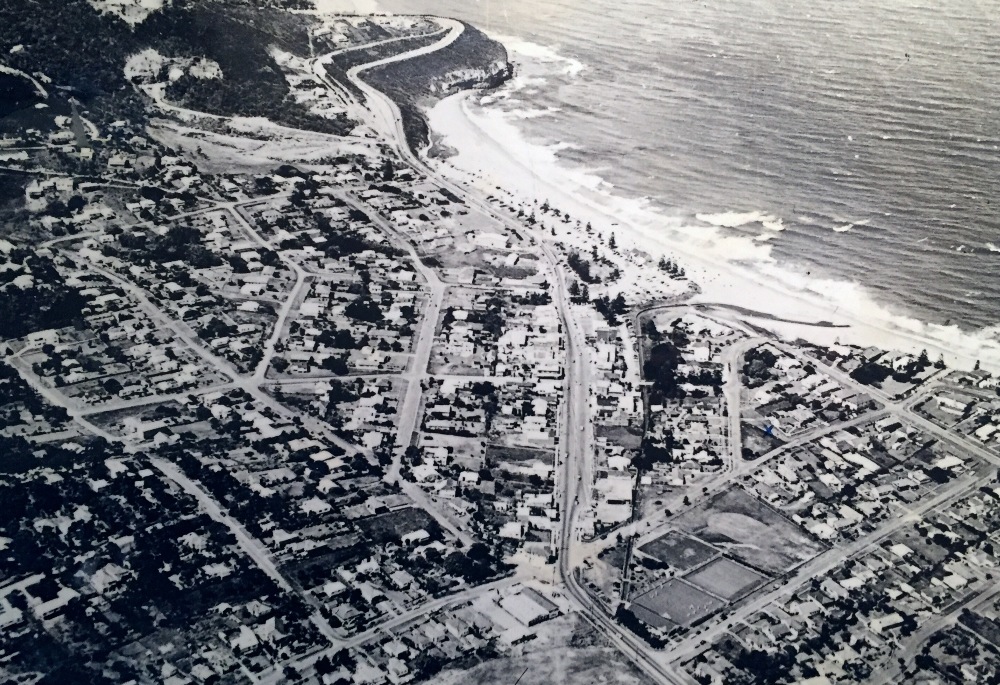
An aerial of Newport about 1957. You can clearly see 'Gretel Park' and the drains etc. that was even before kerb and guttering.
Did you play in that drain?
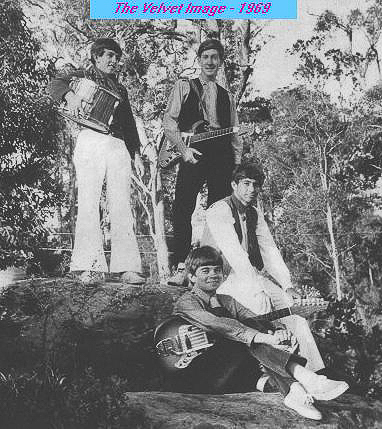 Of course. That was only a little drain though. Behind the shops was the big drain that everyone (us kids) went in, the outlets for which were down near the end of the bowling club. We’d go in there and play. I still remember the little drain in Gretel Park though, and all the duckweed and stuff – how we didn’t die from disease I don’t know.
Of course. That was only a little drain though. Behind the shops was the big drain that everyone (us kids) went in, the outlets for which were down near the end of the bowling club. We’d go in there and play. I still remember the little drain in Gretel Park though, and all the duckweed and stuff – how we didn’t die from disease I don’t know. In my final couple of years at Pittwater High, 1968 and 1969, three other guys and myself formed the first rock band made up of students at the school, The Velvet Image. Steve Marsh, Peter Chick, Mick Davidson and myself played at school socials and other venues on the Peninsular including the first Barrenjoey High school social. Hopefully at this year’s reunion we will all get together for the first time in 47 years.
Right: The Velvet Image 1969 : L-R Peter Chick, Dave Whiteman, Mick Davidson, Steve Marsh
What’s your dad’s name?
Randall, but he was known as ‘Snowy’ Whiteman. He was the boss of the famous 21 Division in the 60’s. When he retired in 1967 he’d wander around in the Summer in just a pair of shorts, no shirt, smoking a pipe and wearing sandshoes. He’d go to Dave Pitt’s newsagent to go and get the paper each morning. One morning Harry Ballarem (the Count), who was the boss of Mona Vale Police Station, saw Snowy sitting on the bus seat there outside the butchers. They pulled in and he sat down with Snowy; ‘how’s retirement going’ and all that sort of thing, and the next minute, he’d handcuffed him to the bus seat…and then they drove off. Here was the old man sitting there reading the paper handcuffed – you wouldn’t have got away with that thing a few years later on, but they were good mates all the same.
What did you do when you left school?
My first job was a Telegram boy at Newport Post Office. I used to ride the Post Office bike around Newport delivering telegrams. I’d do this on weekends and during school holidays.
I used to be involved with the local Newport Chamber of Commerce, more as a hanger-on I’d say to begin with, as I didn’t have a business but knew a couple of guys who were in this. I went to their end of year Ball, which was round at the Royal Motor Yacht Club, and there was a particularly lovely English girl there, an absolute stunner. I found out where she lived, up in Queen’s Parade West, so as a Telegram boy I would look for the letters coming through for her from the UK, and I’d put a stamp on them ‘Hand Delivery’ just so I could deliver them to her personally and see her. She thought it was quite strange. She came from Yorkshire so had a beautiful broad Yorkshire accent... “Ooooohh, that’s looovly, all these hand delivered letters”.
I also worked at the Mitre 10 Hardware store for a while. It was me who upset Tug Wilson, around 1968-69. I had to repaint the ceiling and he would say, ‘come on, get back up there you’ve missed a bit’ and so on. I got a bit upset and so started painting Peace signs all over the ceiling. He’d come in the next morning, ‘get those bloody thing off there!’ and I’d have to paint over them.
The very first job I had when I left school though was working as a Labourer on the Newport Arms, this would have been around 1969. Where the drive through is now there was only a little bar. This was the boat rowers bar, a little outdoor bar. (Brian Friend – where they had a carnival between Avalon, Newport and Mona Vale, all the boat rowers would go back there after a carnival).
The construction company was Green and Lloyd. A local bloke, Peter Anderson, was a bit of a legend around here then and used to drive a cement truck in those days. We used to dig 18 foot piers down to the bedrock so they could pour these for the foundations. These pier holes were about two feet wide. There was two or three others who got jobs as Labourers; Chicka Joyce, whose brother Frank “The Indian” who we’d find asleep under a tree on the way to school, myself and Owen.
They would put a ladder down and we would have to go down and scrape the bottom out so it was just bedrock. One day the cement truck came to do a pour and somebody said ‘where’s Chicka?’ – somebody said ‘he’s probably having a beer’ – they had the weakest bladders those blokes! - somebody would go in to use the toilets, have a beer on their way out, and by the time they got back to the site they’d have to go back in again, and on and on they’d go.
At any rate, he wasn’t doing that loop, fortunately somebody said ‘no, I was just in there and he’s not there.’ Anyway, Peter Anderson had the shute out ready to pour the concrete when someone said, ‘hang on a minute, wasn’t he down scraping the holes?’ We peered down into the darkness the hole and there he was asleep! They were just about to pour tons of concrete – they would never have found him.
Another job was working for Zacchary Stollznow up at his restaurant ‘Zachary’s’ at Terry Hills. They lived opposite us in the Boulevarde. Our family became very good friends with them and I thought I’d like to do cooking and become a chef. When I left school, much to my dad’s disappointment, as he wanted me to join the Police, and being a rebellious teenager, I said ‘no way in the world would I do that!’. I began working at Zacchary’s restaurant on a Friday and Saturday night and Zac would drive me up there. The worst part of that was he would like to sit around after the restaurant closed and get on the turps. I would have to wait for him while he’s doing that and it would be two o’clock in the morning before we’d head back home.
Dad said, ‘if you’re really keen on doing cooking then you’re going to learn somewhere properly.’ So I ended up at QANTAS Flight Catering out at Mascot, which ran 24 hours a day. I had an old FE Holden and would drive in there everyday, although with not the same volume of traffic you have today.
At Qantas I was getting paid $18.00 a week. I was learning the trade but it wasn’t like cooking a la carte meals such as I’d done at Zacchary’s. They would bring trays of steaks out and I would be on that for a week; that’s all you’d do all day – put them on, turn them over, on and on. Boring stuff.
In those days security at the airport was so lax, and because we were in catering and you could have anything you wanted to eat, we’d go into the bakery and get two or three rolls and stuff these with bacon and eggs. Sometimes we’d get rolls and make lobster Thermidor or Lobster Newburg and have this on bread rolls. I was skinny before I started working there, but not afterwards. For lunch three of four of us would take a tray of these out, where the 707’s were parked on the tarmac, and sit in the pilots seat with our feet up on the dashboard eating lobster rolls! No wonder the profits were slim that year! You couldn’t get away with that today.
In March 1970 my dad died of a heart attack. He was just 63. I came home from work and found out he’d been taken to Mona Vale Hospital. They didn’t have the drugs then that they do now so he died very young really.
But he was such a live wire that three days after he initially went in, we went down to visit him at the hospital, he wasn’t in his bed. We asked where he was and the nurse explained he was cutting somebody’s hair (laughs). So he was going around the Wards giving people trims, he’d borrowed some scissors form the nursing staff (laughs).
A week later they phoned us and said we’d better come down, he’d had a relapse, that was the 19th of March, 1970. The last words he said to me were ‘time for a haircut eh?’
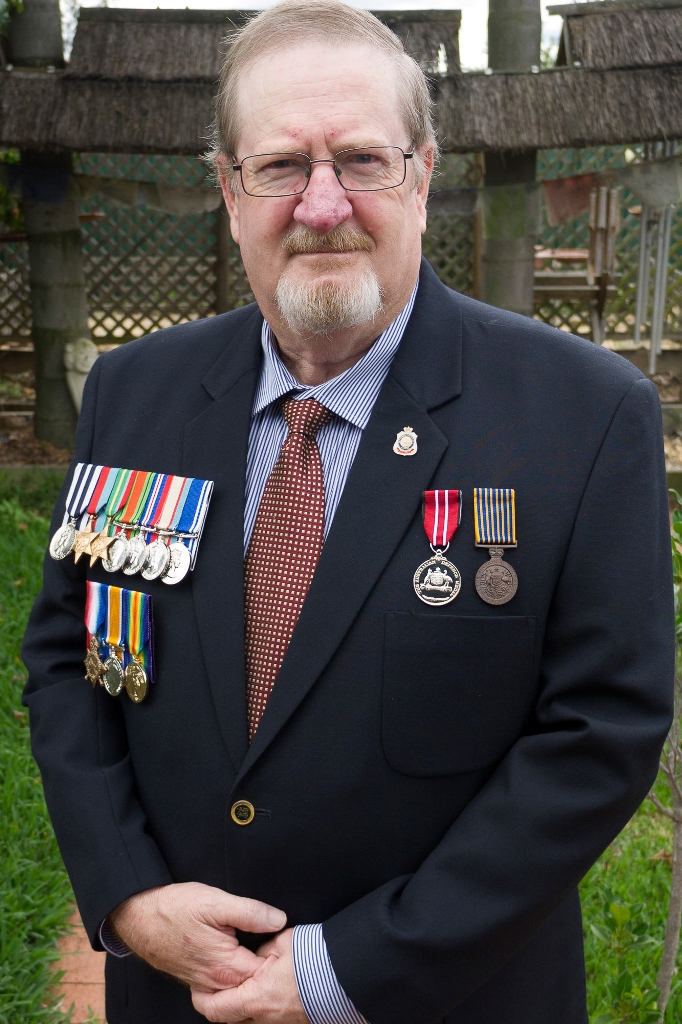
Anzac Day 2015... Wearing my father Randall's (WWII) and my Uncle Rupert's (WWI) medals with my own National Medal and Australian Defence Medal
His funeral was held at St. Michael’s at Newport, where Liz and I met and where I used to play the organ during my teenage years, in fact I played the organ at Nat Young’s wedding. The Minister was Bruce Horton, and all through the vows Nat Young couldn’t keep his hands off his bride, kept giving her little pecks – Bruce Horton was ‘come on, focus…!’ Sounds like he was focused though…. (laughs)
I used to surf with Nat Young and Midge Farrelly when Newport Reef was working. Robbie Porter and I would go surfing before school and we’d go out off the reef. If Robbie wasn’t there I’d still go, and this was prior to leg straps, and we didn’t worry about sharks or anything like that. It was a long swim if you fell off!
An event of enduring significance was the meeting of my future wife, Elizabeth Parkes, at the St Michael's Newport fellowship group in 1967. Yes we were school sweethearts and eventually got married at St Michael's in 1977, and will celebrate our 40th Anniversary next year, 2017.
After a while of driving into Mascot and being on $18.00 a week I decided this wasn’t any good. So I started with a company called Compunet at Artarmon, who at that stage had the largest mainframe computer in Australia, the Univac 1108. I worked as an operator – QANTAS later got one of these. Compunet was a computing bureau where programmers would come in with punched cards. We would feed these into the card reader, and load the tape drives. Very interesting work and I could see a future in computers. I was on $50.00 a week.
During the time I was there I drove my FE Holden and there was a chap dad used to give a lift to work, Jim Blows, who lived at Mona Vale, and whose wife played the organ at our wedding. Jim would wait at the bus stop at the corner at the top of Bungan, near the Eleven Mile Store.
I saw him waiting at the bus stop there one morning when I was on my way to work and thought I’d do the right thing. I did a u-turn and went down to come back up, it was a foggy morning. I looked up, couldn’t see anything, turned right and bang, I’d hit a motorbike, or rather he hit me. Fortunately I didn’t kill him but his leg was shortened after that – Ted Zann. They lived in Newport. for years I used to see him and his wife often and he walked with a limp. That was the end of the FE Holden.
Ironically, years later when I was part of the Highway Patrol, I was chasing a bike one night from Newport up the hill and across the top of Bungan and there was a similar incident. The bike went left and another car in the middle lane – Kenny Bulger veered right and I veered left – the bike went into that little road there, and I ended up ruining the Charger right on that same corner there, a second accident on the same spot.
Compunet had a reshuffle and got rid of three computer operators. I then went to work at Cemac at Brookvale, so I was in Timber then for a year or so.
A school mate of mine at that time, Tom Brown, lived in Mona Vale and came up one day and said, ‘guess what boys – I’ve joined the New South Wales Police Force’. I was a bit shocked but thought, ‘if Tom Brown can join the Police, I can too’.
I applied, and because my dad had only left three years before, I still knew Inspector Roy ‘Curly’ Slocombe, who was the boss of 21 Division at the time. I went in and saw him and he said he’d give me a reference but I had to be fit and fulfill all the qualifications. I was successful in my application.
Tom Brown later turned up and he’d received a letter stating they’d knocked him back. He’d been caught speeding in Queensland and had forgotten to tell them about it. They said he hadn’t been honest but it was merely an oversight but he got knocked back.
I started in Class 129 on the 1st of November 1971 and did six weeks at Redfern, which was the Police Training Centre, the PTC. Dad used to take me out to the Depot when he’d work on a Saturday at 21 Division and so I knew all the Police horses by first name and would crawl all over the motorbikes and sidecars. So it was a bit like old home week for me but when you went back there with Sergeant Andrews as the Instructor it was a different matter. You weren’t allowed to walk across the Parade Ground – there were rules, an etiquette that applied. I remember this caused problems when dad was head of 21 Division as each Christmas they’d go out and rip up the Parade Ground to plant a Christmas tree, which of course upset the drill staff!
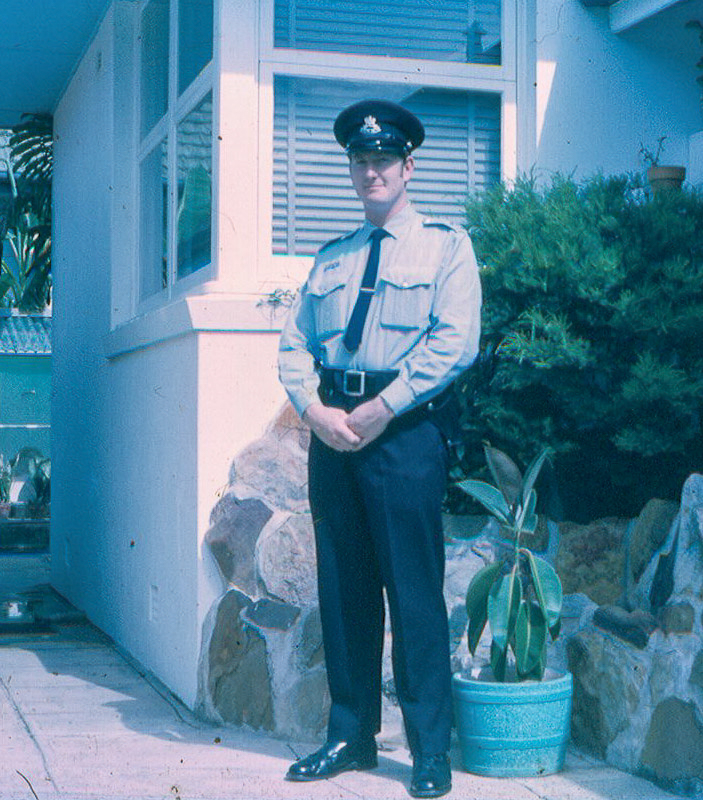
First day as a new Police Constable 16th December 1971
I did my six weeks there and was then stationed as a Probationary Constable at Manly with three other guys, sadly one of them passed away New Year’s Day this year, Ventry Lewis, a good mate and a lovely chap. That hit me hard.
While I worked the beat at Manly, Bumper Farrell was the 1st Class Sergeant and I worked with him as a driver. Winter would be interesting; he was a chain-smoker even though he was a superb sportsman, so he’d drive around with the window open, freezing cold, I’d be shivering behind the wheel, and he’d be at me... ‘man up!’.
The author Larry Writer asked me for some stories to use in his book about Bumper and I mentioned in one of these that even though he was a tough man there was a real empathy for everyone in him too. One day we were called to a deceased on Manly Beach. The car crew were already there but we went down and this was an immigrant family who really had no friends in Australia. They lived in Marrickville, had gone to the beach and the old man had laid back in the sand to sunbake and just didn’t wake up. The wife and the kids were pretty distressed so Bumper said, ‘right, we’ll take them home, we’ll leave the rest of the formalities for the moment.’
We drove them home to Marrickville and went into the living room, Bumper said to me ‘go and make a cup of tea for these people’. And we stayed there with them and he comforted here and made sure they had some kind of support there – he told me to go find the neighbours, go find someone to be here for them, to stay with them.
He really had a soft side to him, he was a very good man, a terrific cop. There were a lot of good Police that I worked with at Manly.
I was then transferred to Mona Vale and Brian Friend was at Mona Vale, that’s where I first met him. Being the most Junior Officer there I got all the station duty – and what was known as ‘fatigues’ where you had to do all the gardening. Harry Ballerum used to tell me I’m doing the garden tomorrow, mow the lawns, all that – I’d respond ‘I didn’t join this to do bloody gardening’ – but garden I would. I hated doing that.
Harry Ballerum was called ‘the Count’, he was a spit and polish man, apart from when he was handcuffing dad to the bench, but Mona Vale then was fairly quiet – ‘Koala Park’ they called us. The Collaroy boys were jealous because if we had to go out in the car and didn’t have a station boss rostered on, we’d have to put all the calls through to Collaroy.
(Brian Friend: There was a bit of a ongoing jesting between Don Freudenstein, the boss of Collaroy and Harry. One day when there was no one else to do fatigues Harry went out to mow the lawn himself – now Harry was a short skinny bloke with a big belly. As he was finishing doing the mowing the phone rings, he answers and it’s Don ringing to say ‘I’d like to make a complaint about the pregnant woman mowing the lawn – I don’t think that’s a good look’.
Harry gave him a mouthful of course and hung up. Christmas time was good as we’d all get together, we were all mates ultimately, all wore the same uniform and worked together.)
Did you go out on the Water Police too Dave?
Yes, I did – I crewed for John MacNamara, who was actually the Officer who attended my accident when I hit the guy on the bike. I did some days with him and also crewed for Buster Brown. I recall once we had to go to a yacht off Palm Beach, that was pretty hairy, nothing like what Brian had to do of course though.
More often than not I would be on station duty though, being the junior officer. I’d sit on a quit night on the veranda and watch the cars go by and would see the Special Traffic Patrol (Highway Patrol) guys in the Mini Coopers in those days; Frank Daniels, Brett Scott Young and Gordon Hay. They would park opposite the station watching the cars coming through. When one came through a bit quick they’d take off after them. After seeing this a few times I thought ‘that’s got to be better than sitting here’. I spoke to Stuart McCloud, ‘Old Silver’, and explained this is what I wanted to do, Special Traffic Patrol duty.
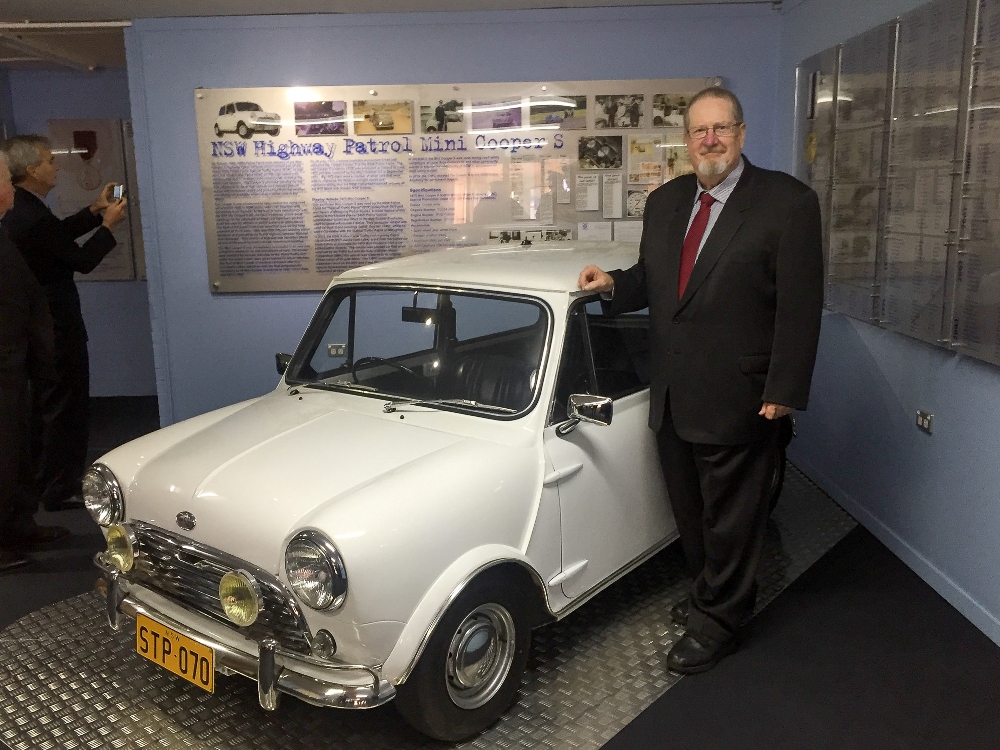
As a guest of Assistant Commissioner Corboy A.P.M. at the unveiling of the Special Traffic Patrol Mini Cooper 'S' at the Goulburn Police Academy in July 2016
(Brian Friend: in 1974, when we went from 14 Division, which was Manly out, to 29 Division, our own Division, we got our own Highway Patrol.)
Dave: When it was 14 Division, Manly to Palm Beach, if there was a job going and we were going past, as the Highway Patrol, we’d attend it, even if was just to settle he situation down or assess the situation until the local General Duty guys arrived. There was a bit of a culture then where the Detectives would give the Highway Patrol some lip, they called us ‘the cockroaches’.
I remember one Christmas party at Manly where one Detective, whose name escapes me, was giving the Highway Patrol boys some lip, calling them cockroaches etc. I stepped up to him and asked him how many lives he’d saved last week. “What do you mean?” How many lives did you save last week? I then explained I’d stopped 40 or more speeding, arrested a few drunk drivers and given tickets to a few who drove dangerously. I don’t know how many lives I saved but I knew it was more than him – food for thought. I never heard any criticism from him again, he realised there was another way to look at our different roles within the Force.
I went to Manly on the Special Traffic Patrol, the STP as it was called then. John Ley was the boss there. This was all spit and polish, you had to Parade in the morning there, very different to ‘Koala Park’.
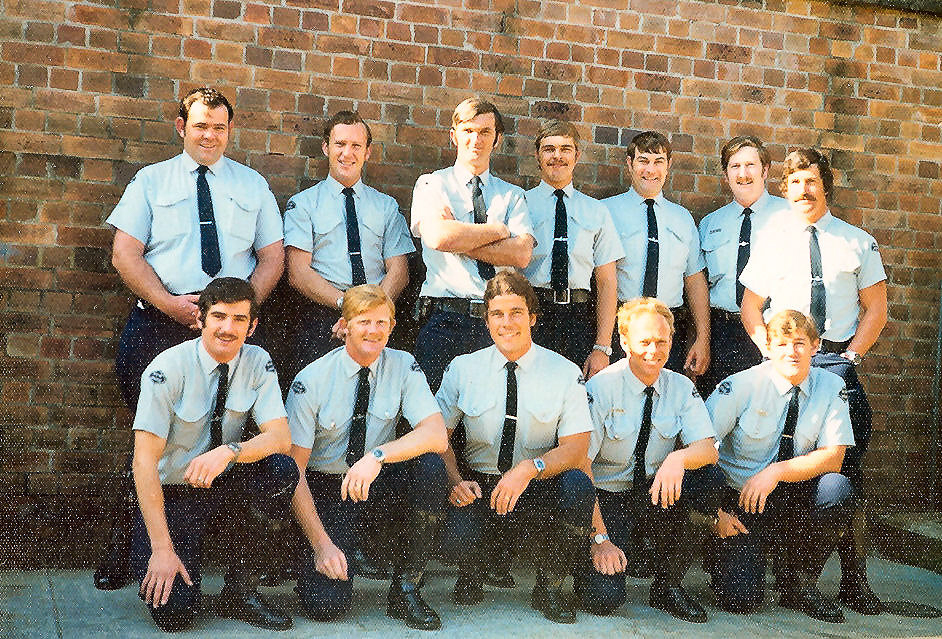
Manly Special Traffic Patrol about 1973... (Dave back row 2nd from right.)
I did the course up at St. Ives. At that stage we’d just got the Torana’s. The STP changed to the Highway Patrol and then as Brian explained they split the Division up. Some of the guys went from Manly to Mona Vale. Bill Marcroft was the boss out there then, one of the Inspectors.
I stayed at Manly, did the usual Highway Patrol things; attending accidents, attending Court for cases.
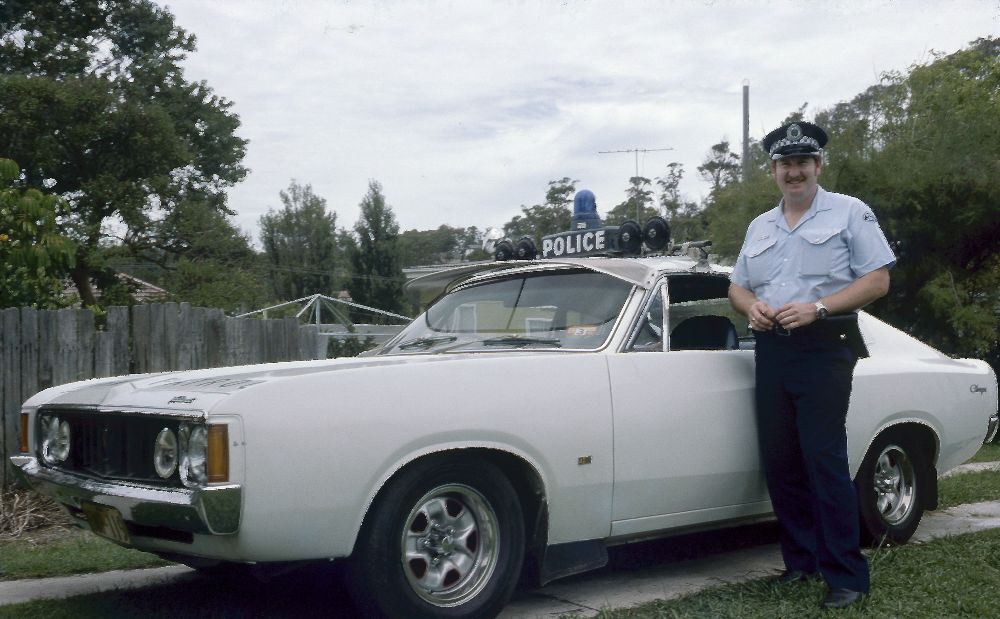
Manly STP 14/41 about 1974
In April 1977 Lizzie came back from America, where she’d been staying with relatives, and we got married, at St, Michael’s church at Newport where we first started. We lived in Manly Vale at this stage and the Highway Patrol moved to Frenchs Forest.
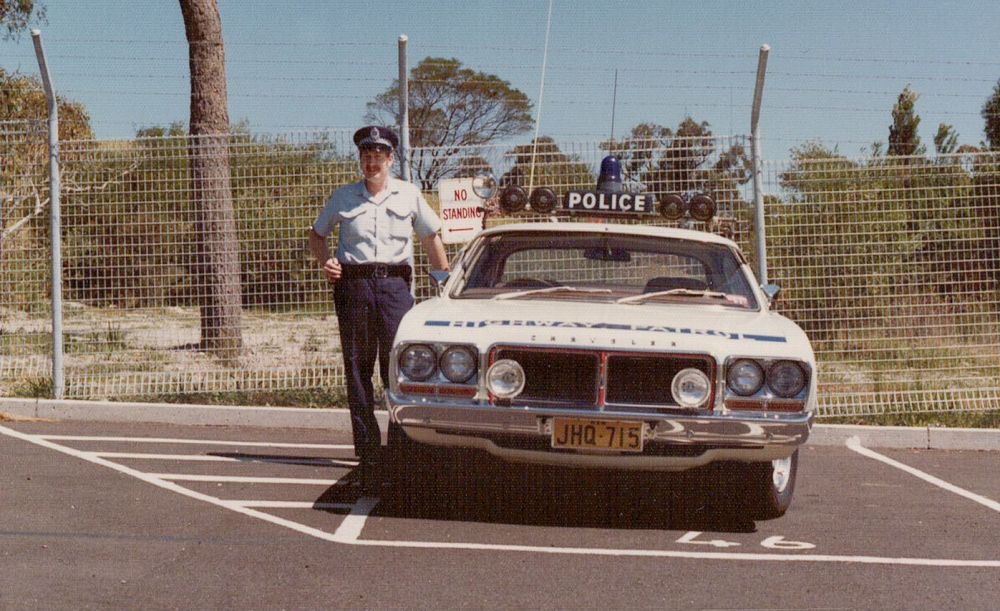
Frenchs Forest Highway Patrol 14/41 about 1980
What was the worst experience you had while doing Highway Patrol duties?
People don’t understand that alcohol and driving don’t mix. I couldn’t count the amount of accidents I had to attend due to this.
(Brian Friend : I don’t think anyone understands how horrific it can be having to attend some road accidents. Younger adults think they’re ten feet tall and bulletproof and it’s only when it happens to someone they know or a member of their own family that they realise this is something that scars you for life – you never get over it.
Nowadays this is compounded by a drugs problem, which is causing more of the same.
As a Police Force member, it’s like anything else – Ambulance Paramedics for instance, if you can’t handle it, you have to get out.
We were blessed in our day in, if we had had a hard day, we could go over to the club at Mona Vale, have a beer with our mates and be able to say ‘I had a sh*t of a day today’. You could talk to somebody that could relate to it.
Today the General Duties Officers have to do a lot of hard stuff but there’s a lot who have never seen anything like these accidents or many of the other incidents others have to attend where something tragic has occurred.
For the average General Duty Office, or Highway Patrol Officers, they see this all the time and it can get to them, of course it does – if they have mates they can go and have a beer with and talk about it, it’s the mateship, that’s what we lived by – that was our code of honour.
If you could get it off your chest before you went home you could get on with it. Today they let them fester and then decide to send them to a shrink – someone who has come out of university and never seen a dead body but will tell them how to react or deal with seeing a dead body – what can they possibly know?)
Dave: I was talking to a bikie on Sunday, a Harley man, and we spoke about this very thing too. He said ‘it must be hard for the Police to see all these things and have to deal with them’. I explained that now they have all these counsellors but the problem is the counsellors have never seen any of this stuff, so there is a gap between theory and reality.
We dealt with it in different ways, and Brian has spoken of how he dealt with it. Back in 1976, I was at Manly at the time, on afternoon clearway duty in a marked car. A call came over that a truck had come down Woodland Street at Balgowlah and smashed into a block of home units.
As I was in the next street I called in and went to attend. There was traffic everywhere. And here was this truck with a tray and a cab which should have been this wide but was now this wide. He’d come down the hill, lost the brakes and taken out the ground floor of this block of units at the bottom of the hills. All the stuff on the back of the truck had come forward too.
I grabbed some bystander and told him ‘you’re on the radio, I’ll tell you what to say’. They cleared the channel and started other Police and emergency services on the way.
The driver was squashed up in the cab, the handbrake had gone through his leg – he was in a bad way but he was in shock. I told him he’d be alright and told the guy on the radio – tell them we need paramedics, more police, a rescue vehicle, everything!
The truck driver kept saying to me "how’s my boy? How’s my boy?” I kept telling everything will be alright. The other Police arrived, and the Ambos and Rescue Squad, Col Coleman brought some doctors from Manly Hospital.
I went around to the other side of the cab, here was all this brickwork all over the place and on the truck, and saw down between the seat and the front of the cabin which was squashed to about a foot wide, two little shoes. I reached in and the little boy was still warm – he’d been on the seat asleep. When the truck hit the wall he’d fallen forward off the seat and had been crushed instantly.
The driver they put drips into, and we had the rescue squad there. He got taken to Manly Hospital and the little kid was taken to Manly Hospital morgue. It turned out the driver’s wife had walked out on him and the kid and left him to look after the six year old child. There was nobody to look after the boy. He’d taken him out with him on the truck.
He’d been working on the brakes on the truck because he couldn’t afford a mechanic. The Vehicle Examination Report showed they hadn’t been put back properly, all that sort of stuff.
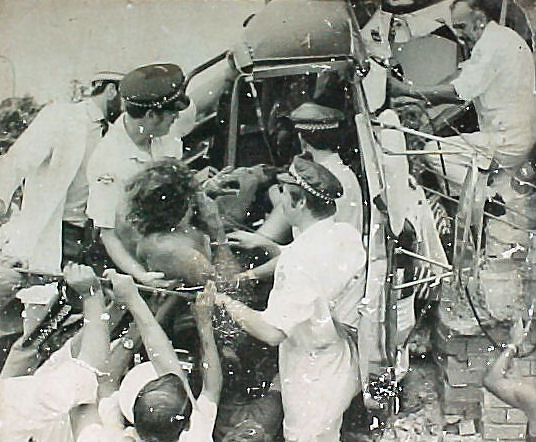
McGrory Truck Accident Balgowlah 1976... Dave holding the injured driver with Keith Giddings, Garry Raymond (Police Rescue Squad) and Graham Jessup (Police Rescue Squad)
The Sergeant at Manly Traffic said ‘you’ve got to charge him, unfortunately.’ I said, ‘you can charge him with whatever you like but I’m not signing anything on this – this poor guy has lost his son’. I really gave him a serve, it was hard for everyone.
So that little guy, that accident, that bugged me for years. It was only late last year when I found him, he’d been buried at Macquarie Park. I went over there with Liz and her mum one day and saw him and put some flowers on his grave. The kid’s father died aged 72 and they’re in a Family Plot there – so that was some sort of closure for me – decades later.
People deal with things in different ways. Brian had all this support and mates around him. Some don’t have that. They can end up going and getting on the turps and developing a problem, what’s known as ‘the black dog’. For me that was the worst one. Little Shane, he would have been 46 now.
(Brian Friend: What Dave there also points out what affects cops the most – and that’s the kids. This is because you relate it to your own kids.
I remember having to attend one, a burnt boat on Pittwater where we had to dig a baby out of the bow and get this child up to Mona Vale Hospital.
You don’t forget things like that – they stay with you. You have to go to work the next day anyway, do the Coroner’s Reports, everything associated with such tragedies.
We’re blessed in that we have the support of our wives, I think you can ascribe getting through it all, in a large part, to that, to our wives.)
How long were you on Highway Patrol?
I left Frenchs Forest Highway Patrol in about 1981 and went to the Communications Section. I began as a radio Operator at VKG at Smith and Campbell streets, the old CIB at Surry Hills. It had once been an old hat factory and now is very smart very expensive apartments.
They had the scientific section there too and this is where Michael and Lindy Chamberlain’s car was for months, down in the basement while all that investigation and court cases were going on.
While I was an operator there a few other guys from 14 Division were there. I was put on Channel D and E mostly, which was the North side of the Harbour, and this was great as I knew the area and knew those who were doing the work.
I was there for 12 months and then went into the training area and was training Radio Operators. This involved role playing exercises – the Granville Train disaster for instance, we’d use that as an example. We had radio consoles and we’d be in the other room gradually escalating what was happening to see how they coped and dealt with what was happening and how to manage a situation even though you can’t actually see it happening. Often when we’d escalate the incident, some would get up and walk out, you found out where their stress threshold was.
(Brian Friend: Your Radio Operators were basically the backbone of any job you were sent into. They had to determine what was needed and where and when and how to support those in the field.)
Dave: The Radio Operator had to determine what those in the field were saying, which resources they needed to be called in to help them and they had to take control. You had other operators coming in to help you, getting on the phone to the Ambos, to the Rescue team but you had to get the information out of the those attending and determine what’s actually going on.
The first cop to arrive at the Granville Train Disaster got there and said there’s three people injured when in fact there were 81 and a bridge about to be coming down over three carriages. So the Radio Operator had to get them to look, to get all the information out of them, and work out what was needed – all that was needed.
I would give lectures to classes at the Academy and say to them, ‘what’s the most important thing at the scene of a disaster or an accident – what’s the most important?’ They’d answer; ‘attend to the injured’ etc etc. The most important thing is the safety of the rescuers – simply because if they get injured then there’s more people down and more people you have to send in after them.
At the Granville Train Disaster, if they’d have just gone in all guns blazing, where there was gas, it would have been ‘bang’ – there would have been more people killed. You have got to be able to contain the incident and then make sure the rescuers are going to be safe to work – if you lose another three, whose going to rescue them?
Bob Bell (another old mate who died this year) and I came up with a Program that we submitted to the hierarchy of the Police Department, who took it to the Australian Police Commissioners Conference in Perth, that would address the perennial problem between Police-Ambulance-Fire Brigade.
There was a problem in that calls didn’t even come in to somebody who was trained – they’d be directed to someone at Telecom on the Triple 0 circuit; in other words, last week they were patching through calls on the international circuit and this week they’re on the Triple O circuit.
People would ring up and say this or that is happening and they would ask ‘who do you want?’ …umm, police? And they’d go bang, and put it through to the Police. We came up with this paper for a Program, it was 60-70 pages of outline, where they set up a centre and Emergency Call Distribution Centre – ECDC – which bypassed Telecom/ Telstra so it came straight in to trained people would say ‘what is your emergency?’. If you listen now, that’s what they ask. “What is your emergency?”
They get the information, listen and decide, ok, for this one the priority service is the Ambulance, send it through to there and then they determine, right, we need Police in on this one too, and the Police would be brought in too.
What precipitated this was as the Training Section we would do all the tapes from the incidences; murders, police chases, other incidences, including the Roger Rogerson shooting at Chippendale - he came in and said, ‘Dave, I want the tape from today’. – I said, ‘bad luck, Internal Affairs has already come over and taken it.’
There was an Incident out at Hurstville whereby a young kid had phone a Triple 0 operator, and he was a young immigrant kid where English wasn’t his first language, and had said ‘firing, firing – there firing’ – and they put him through to the Fire Brigade. The Fire Brigade went in, without telling anybody else, and sent a truck to this address and as the Firies are walking up the path – bang, bang, bang - the father shoots the three kids. So this poor kid was saying his father’s firing, had been firing a gun in the house. The Firies then call the Police who go in and find he has shot his family.
We stated this at the end of the report, if they had been able to be having trained people talking to this kid they would have been able to find out what it was and provide the response that was required. This wasn’t a fire.
We had a meeting, did our presentation, the Ambulance head and Fire Brigade Head was there, and we explained we needed to set up an Emergency Call Centre with people trained by and from the Police or the Ambulance or the Fire Brigade – in all three really. We went forward with it and they adopted some of what we suggested in our Report/ Paper. Unfortunately there was some kind of ‘the unions won’t wear it’ so they didn’t implement the whole thing the right the way through the three services.
I then started becoming involved in the early days of Personal Computers and moved into another section, the Telecommunications Technical Unit – we looked after all the telephones for all of the department. We had 17 rows of filing cabinets where they stored all the records for all the phones and radios. We had the first PC (Personal Computer) for the Department, an old WANG PC, which had a 30MB hard drive and a monochrome monitor. I began teaching myself database Programming and wrote the software to track all of the telephones and all of the radios in the Department.
I was living out at Emu Plains by then and so would study on the train to and from work.
It used to take six months to do an audit of all the radios in the Department, determining where they were, what they were doing etc. The Department gave me a dozen data entry workers to implement the Program and put all of this data in. Once we had done this it took five minutes to print a report of where every telephone and radio was. I received a Departmental Award for the work I had done from the Assistant Commissioner for Services. I’d trained up another couple of Public Servants who had been allocated to work with me on this.
Another quite new item then was a Word Processor. I typed up a report on one of these and took it round to the Superintendent who was well known for being finicky on how everything was termed and would mark your reports with what needed to be clarified or modified to make them correct as per the way they were to be done.
You would end up with a 20 page report with red pen marks all over it. Prior to this reports were all typed up on your old typewriter, so correcting them or making modifications was another task on top of the already quite lengthy in some cases report. This particular report received the usual corrections and was handed back to me to go and change. I reappeared minutes later, due to being able to use the Word Processor, and the Superintendent was amazed. He decided everyone should have one of these.
Why Emu Plains?
My maternal grandparents lived in Penrith. We used to go out there as kids when they still had steam trains, it was a big country town then. My brother lived out there, built a house at Kingswood and Liz and I would visit him every month.
One of my nephews left school and went into Real Estate. At that stage we were living at Telopea. We went out to visit my brother Max one weekend and my nephew wanted to show us some houses as a practice exercise. We saw a few places and then visited this place at Emu Plains that was owned by a Greenkeeper and his family. It was $59,500 – we thought, ‘cripes, even if we buy it and just keep it for a couple of years we’ll do well.’ Well, we’re still there.
In the meantime my other duties at the Telecommunications Unit was to go out and install Eagle Phones at country Police Stations. The Eagle Phone was a call diversion unit as country police stations, let’s say Bulga for example. If there was an accident on the Putty road for example, and this is in the days prior to mobile phones, someone would call into the Police Station and knock on the door and the station officer, who usually lived on the premises, would then phone Maitland or Singleton and get cars to attend. If the officer was off duty, then he was entitled to claim for three hours overtime minimum just for attending to that knock on the door or for taking a phone call.
They had decided this needed to be stopped, the budget was being blown out by this, and so they decided on installing these call diversion units. On one man Police Stations there would be a unit on the front of the Police Station where you would press the button on the unit, a recorded announcement would ask you to hold while your call was redirected, and the internal workings of the unit would send the call through to Singleton. If they called through it would be switched over to Singleton and then if that office wanted the officer stationed at Bulga they would call through on another line.
I was tasked to install these Eagle Phones and got to visit everywhere. I just wished I’d been more involved in my photography then as I am now – I visited almost every Police Station in NSW and saw some beautiful scenery.
I was then head hunted by the Police Computing section who wanted to set up a new micro-computing group, which is PC’s, they wanted to bring PC’s into the department to so that people could do word processing and other use other programs just being developed for PCs.
I had to become a Public Servant in order to make the change so I resigned as a police officer and became a Grade 6 Public Servant. I believed that my future lay in information technology and computing. I was writing software for different units in the Department including the Police Air Wing and I had a team of Programmers whom I was training to write database software for PCs. The Department put me through a Systems Analyst Course at the same time.
I was then given the task of allocating 260 Wang PCs to different units and stations within the Department. Having been out to the country Police Stations and all these officers banging away on old typewriters, I thought that’s where they should go. The city and surrounds Police Stations already had office workers to help them with their paperwork. Unfortunately police politics raised its ugly head and most of the PCs went to city stations. The poor country coppers had to put up with typewriters for a few years to come. This episode left me pretty disillusioned and disappointed in the way things were going.
About this time I got a phone call from the Kerry Hobbs the CEO of Ashton-Tate, which was the third largest software company in the world at that time. They were the developers of dBase, which was the computer language I programmed in. Apparently they had heard about the database applications I had been developing which was considered cutting edge stuff at the time. They made me an offer to go and work for them, at three times the money I was getting as a Public Servant, to which the simple answer was ‘when do I start?’.
I jumped ship and joined the corporate world – they were out at Epping and then Neutral Bay. I then found out what the corporate life is all about. It was pretty cut throat, nice on the surface, but that was just a veneer. When you work in the Cops you’re working with people that you like and got on well with. There may be some that you didn’t particularly like but that didn’t matter because you knew if you were going into a situation they had your back as surely as you had theirs. You knew you could rely on them. That didn’t work in the corporate world, it was dog eat dog on the way to the top.
I’d been writing software for aviation companies as back in 1972 I learnt to fly and would fly on my days off.
What were you flying?
Light twin engined aircraft, Aerostars, Aero Commanders, Navajos, Partenavias. I flew Islanders down at Wilton doing parachute drops. I had a few interesting experiences there I can tell you!
Where did you learn to fly?
Camden, it cost me $10 an hour in those days. Tony Wright, whom I used to work with on the Highway Patrolo, learnt to fly in Cyprus when over there with the UN. We both came to know people in General Aviation and would fly what they call the ‘Bank Runners’. We would leave Sydney on our days off in nice twin engine aeroplanes and fly up to Tamworth and Armidale, Inverell and Moree, dropping off bags of bank documents and then back to Sydney. I had helped Vic Walton set the up the boatshed and float plane operation at Palm Beach when he first started there. Phil Yates, Ian Chessel and Ian Long flew for him for a while. Vic also had HobieCats there at that stage and I or one of the others would take people out on Pittwater and set them up, give them training in how to sail them.
Around that same time, the mid 1970’s, Vic was in 22 Squadron, which was the RAAF Reserve Squadron based out at Richmond. He talked me into applying to join the RAAF Reserve explaining the great trips and planes you could go on. I joined the Reserves and was commissioned as a Flying Officer in the RAAF on a part time detachment to 22 Squadron.
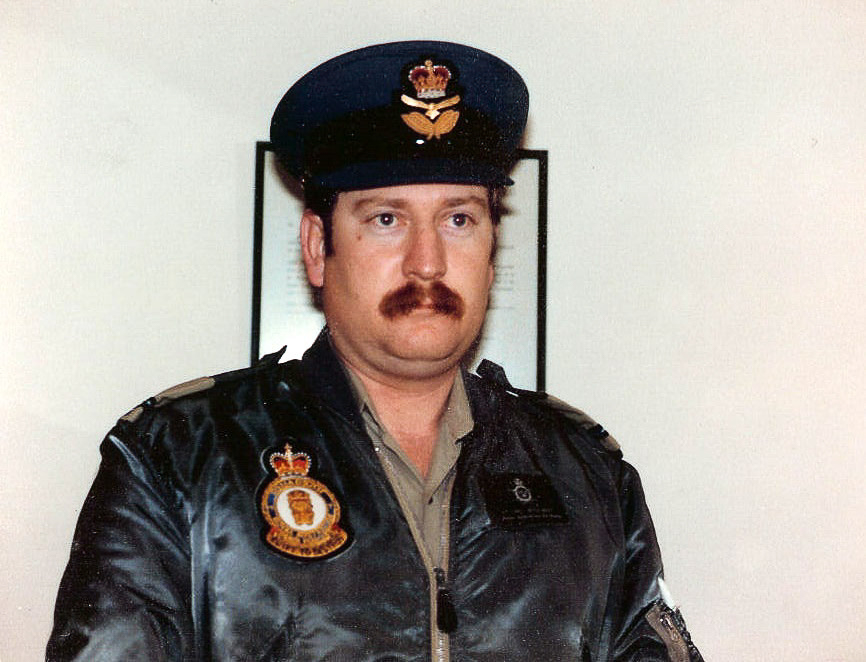
22 Squadron RAAF 1979
I did three or four Multi-National Exercises, while attached to 22 Squadron. Vic and I were in Operations and would go and man a BOR or Base Operations Room on a base or wherever there were flight ops. I did Operations up in Townsville on one occasion and attached myself to 77 Squadron, which was the Mirage squadron from Williamtown. I was fortunate to chalk up about 20 hours in the Mirage. Flying a Mirage was just unbelievable; we’d go out off Townsville and bust holes through clouds, amazing stuff.
I took part in an exercise, Kangaroo III, in 1979 at Rockhampton with 77 Squadron as an Ops Officer there. This involved tasking the aircraft, briefing the pilots and because I was a pilot you spoke the same language. Sometimes you would go out in little small aircraft, Winjeals, called FAC’s, Forward Air Controllers. These were slow aircraft that could fly low and would spot targets for the Mirages which were so fast they couldn’t actually eyeball a ground target. The FAC would fly along the top of ridges and down into gullies, it was real stomach churning stuff because you were all over the place. You would then call the Mirages in and provide visual references so they could do a hit on the target, which during an exercise might be an old truck or abandoned building.
While at Rockhampton I was assigned as RAAF Flight Operations Co-ordinator aboard the United States Navy USS Tripoli LPH-10. The Americans were involved in this multi-national exercise. I jumped on a CH46, which was like a Chinook but a smaller version, with its rivets hanging out and I thought, ‘geez, this thing could fall out of the sky.’ But we got there. We flew out into the Coral Sea about 30 miles to the USS Tripoli, which was an amphibious assault ship. My duties involved coordinating air operations for the exercise between the RAAF and the US Navy. I made a very good mate while aboard whom I still stay in contact with.
While on the Tripoli I got to ride in a Cobra which is an attack helicopter. They were going to do a strike on Townsend Island, which is in the Military Area at Shoal Bay. It was a bit like a scene out of ‘Apocalypse Now’. You took off and you wore these goggles with crosshairs that were connected to a joystick between your legs. Wherever you put those crosshairs that’s where the 20mm gatling gun would fire. You would come in at about 110 knots, line up the target and watch the tracers, the whole seat and you shaking like anything – that was pretty memorable.
So I’d already been developing software for the Aviation Industry, didn’t enjoy the corporate world especially, and the company had been taken over by another and shed a lot of people, so I went out on my own and began developing and writing my own software.
As well as writing database applications for many different industries I wrote software for Toyota which led to another contact and I ended up in Brisbane writing software for a small insurance company, which became a big insurance company and was recently taken over by Suncorp. I developed and wrote all their software, prior to that, for 17 years.
I’d also always been involved in Photography. When I was a Telegram Boy in Newport riding around, I used to hold up an old 35mm slide holder and look for pleasing compositions. I ran ran up the back of a few parked cars while doing that! I had a box Brownie then.
In 2002 I had a heart attack, then developed Diabetes Type 2 and then I had a hip that needed replacing. After this I went for a trek around the Himalayas with an old mate.
This led me to becoming more involved in Photography. I began entering competitions and won awards in every competition I entered, from regional Photography Exhibitions to winning corporate sponsored competitions such as the Country Energy comp at Oberon a couple of years ago. I’ve sold a lot of my images to corporates overseas and my work has been published in magazines and books both here and overseas. It’s like it’s a whole new career for me. .
What sort of subjects are you choosing?
I started off as most people do photographing Landscapes. Landscapes are a good place to start as they don’t move, they don’t argue. During the last 12 months I’ve been doing a lot of Portrait and Model work. I still do Landscapes as well though.
I’m also involved in the Penrith RSL Photography Club, last year winning both A-Grade trophies for Monochrome and also Colour. But if I don’t just head out on my own I also have photo shooting mates I go out on photo shoots with. Aside from my personal photography which I do for enjoyment, I have been doing more and more commercial photography work.
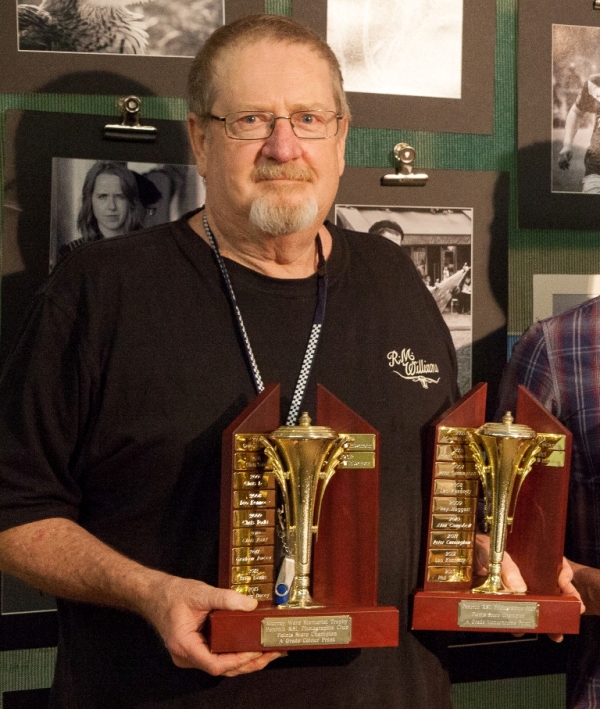
What are your favourite places in Pittwater and why?
I’d have to say Newport and Newport Beach. Newport Pool has featured in many of my photo shoots – I still go there, it’s a special spot with many memories. Newport Pool is where I learnt to swim too. I was Captain of the Newport Swimming Club in 1966 and was involved in the Learn to Swim Program there, so there would be kids out there now who I taught to swim. If it was a sunny day it was great, if it was a dull day we’d still go down there and start a fire and put some potatoes in, bake them, go surfing – great stuff, wonderful memories. It’s also where Liz and I would meet up, so that makes it a special place too.
The park at Newport where I played rugby for the Newport Rugby Club and nearby, the 1st Newport Scouts. I was a scout there when they built the current scout hall and then transferred to Bayview Sea Scouts after I got my sailing boat.
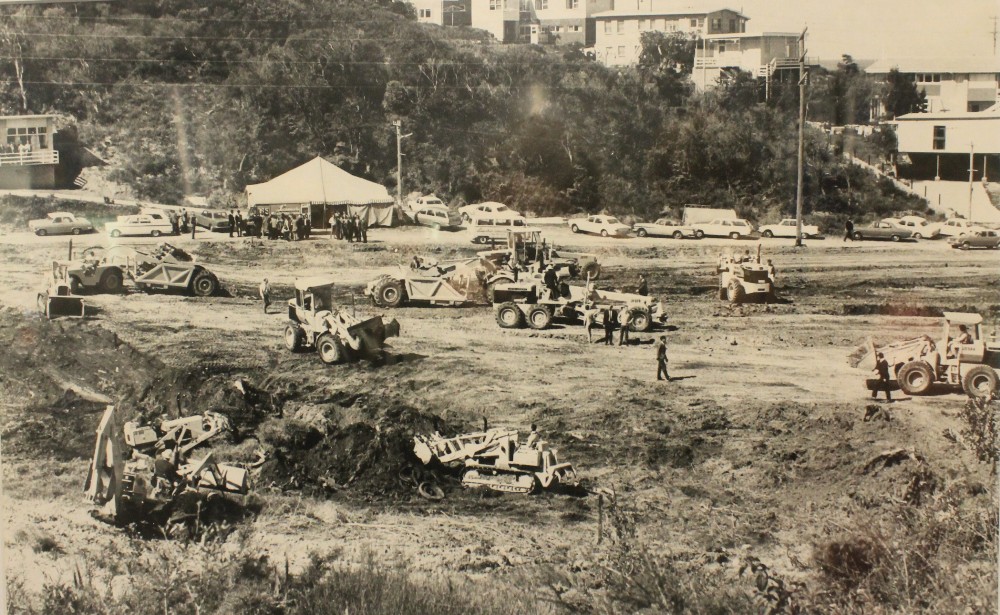
Newport Rugby Club - The Breakers - circa 1969 - 'making a playfield' - courtesy Newport Ruby Club
As a teenager I had a sailing boat, a Heron, and I used to race on Pittwater from BYRA, the yacht club at Bayview. Pittwater was my backyard and it has never lost its appeal for me. But living, growing up and then working in and around Pittwater and the Peninsular was just magic and it will always have a special place in my heart with many fond memories. I still visit often and do photo shoots there… it’s a special place.
I have recently become involved in an annual Pittwater High Reunion group (held first in 2014 at the Newport Arms and subsequently at the RMYC) for those who attended Pittwater High between 1963 (the year it opened) and 1972. Our next reunion will be on 22nd October this year and anyone who attended Pittwater during those years are welcome to come along, no booking necessary and all very informal. But a great opportunity to meet up with old school mates..
I’ve also just recently been elected the Chairman of the Northern Metropolitan Retired Police Association, taking over from Brian Friend OAM. It’s a great way to keep in contact with many of my old Police colleagues.
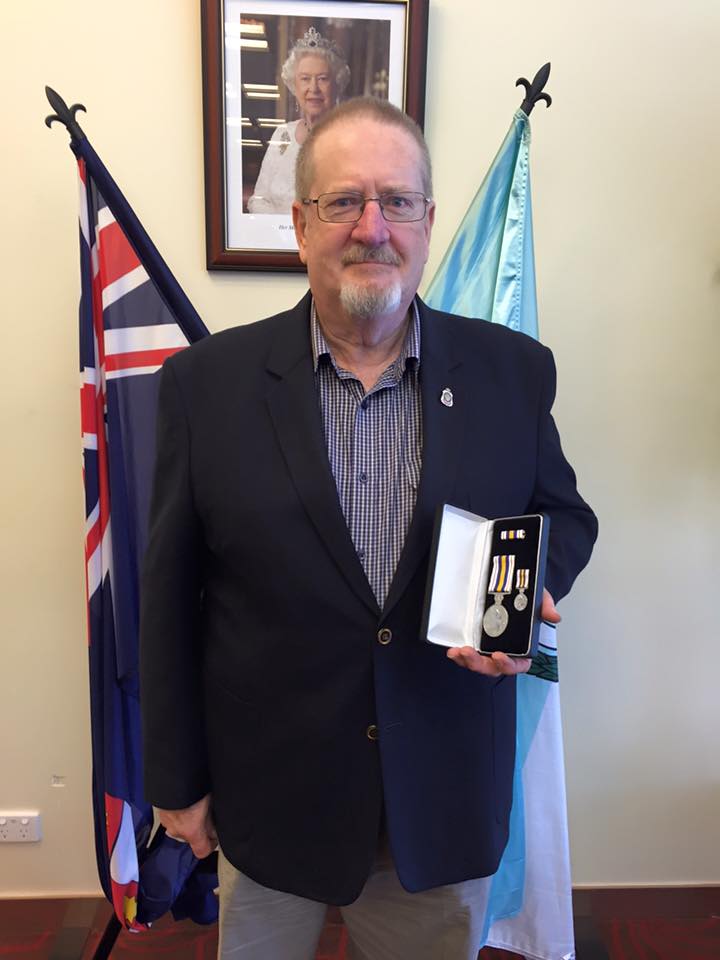
David being presented with the National Police Service Medal earlier this year.
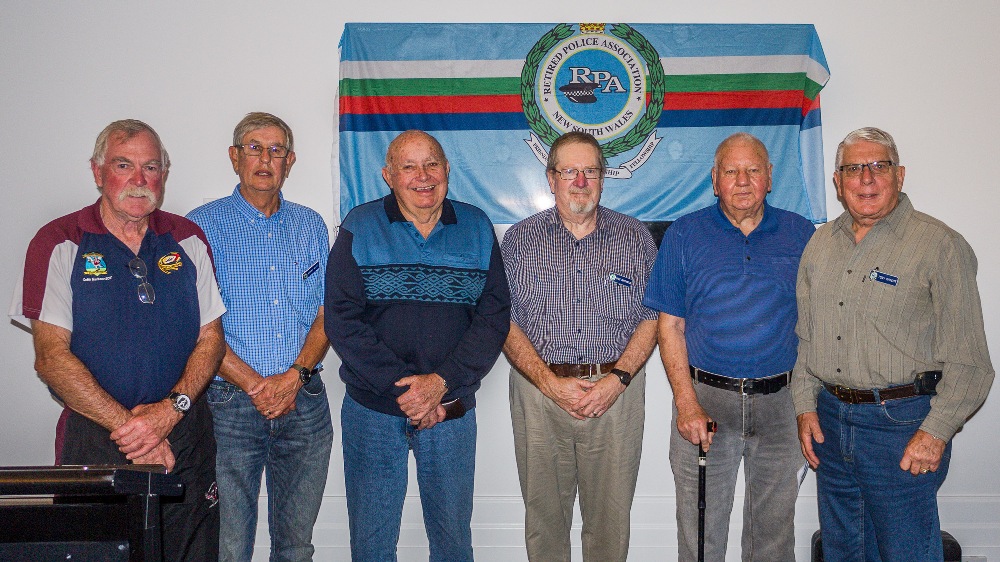
2016 Northern Metropolitan Retired Police Association Executive : L_R Brian Friend O.A.M. (Vice Chairman), Barry Miles (Welfare), Trevor Swift(Welfare), Dave Whiteman (Chairman), Jim Soiland (Welfare) and Tony Wright (Secretary)
What’s your ‘motto for life or a favourite phrase you try to live by?
My dad said to me, ‘in life you’ll meet a lot of people. You will meet some people who teach you good things and others who will teach you bad things. Listen to the good things and you won’t go far wrong. Forget the rest of it.’
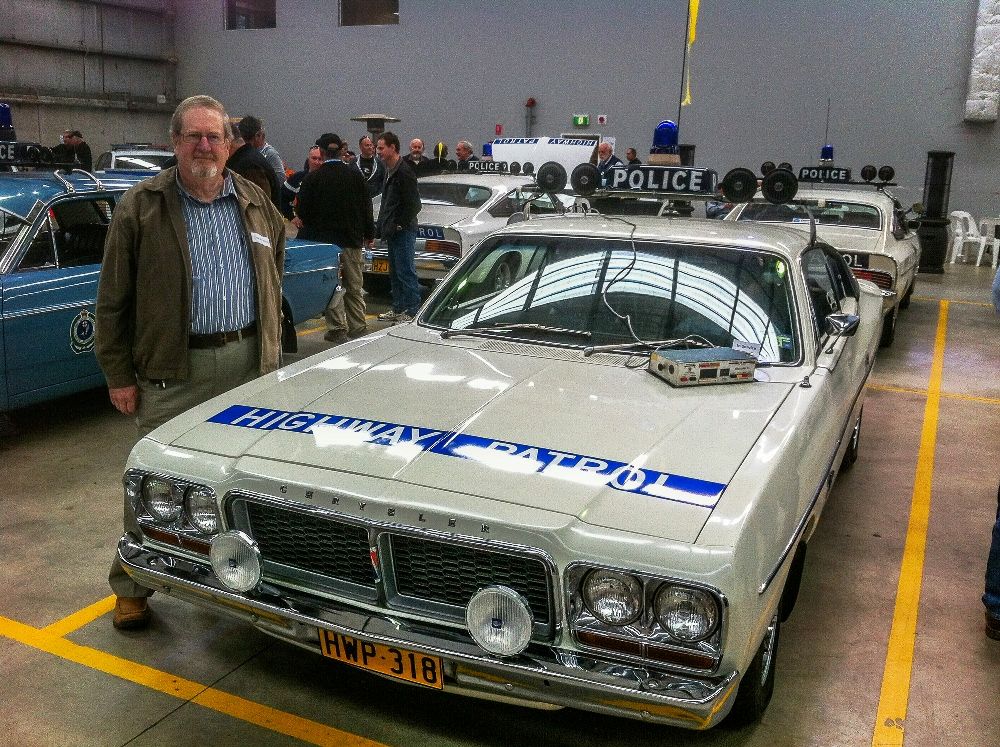
Highway Patrol Charger and Digidar Radar at the Retired Traffic and Highway Patrol Officers Day 2015.
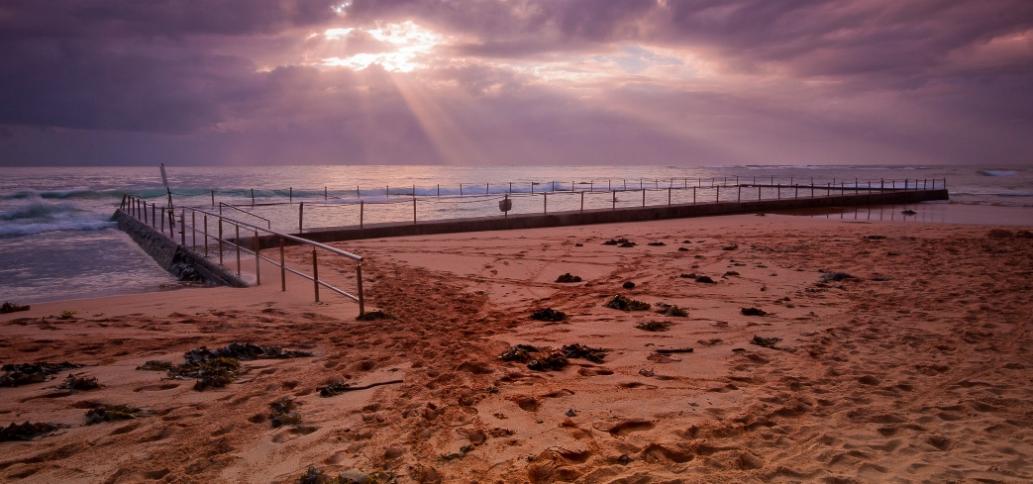
Newport Pool - copyright Dave Whiteman
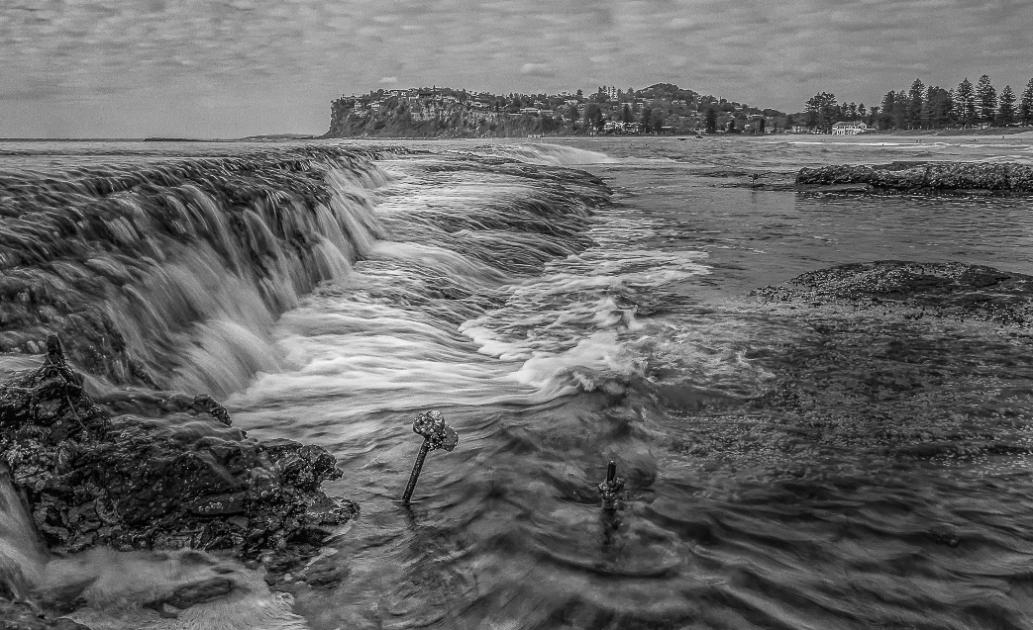
North Newport - copyright Dave Whiteman
Dave Whiteman
Dave Whiteman has been a keen photographer for over 60 years.
Growing up at Newport Beach, he used to photograph the area with a Box Brownie camera, often while out on his rounds as a Telegram Delivery Boy riding his bike. His passion for photography and particularly seascapes and landscapes has only increased over the years, but it was the advent of Digital Photography that allowed him to explore other genres.
Dave has photographed most of Australia and has traveled to much of the Pacific, South East Asia and India to add to his portfolio. What started as taking portraits of friends and family has led to the rewarding and challenging world of fashion and model photography, often at locations on the Peninsula but also in the Blue Mountains and other stunning locations.
What started as an interest has become a second career for Dave and he now undertakes commissions for corporate photography work including in the transport, aviation and construction industries. He was quite emphatic that he doesn’t do weddings but has shot the occasional engagement or 21st.
Dave has won awards at every photographic competition he has ever entered, including regional shows and exhibitions and corporate sponsored events. Adding to a string of awards in previous years, he won both A-Grade trophies for Monochrome and Colour in 2015 at the Penrith RSL Photographic Club where he is a member. He also runs independent photographic workshops, is a sought after speaker and trainer and has had several successful exhibitions of his work. His images have been published in magazines and books both here and overseas.
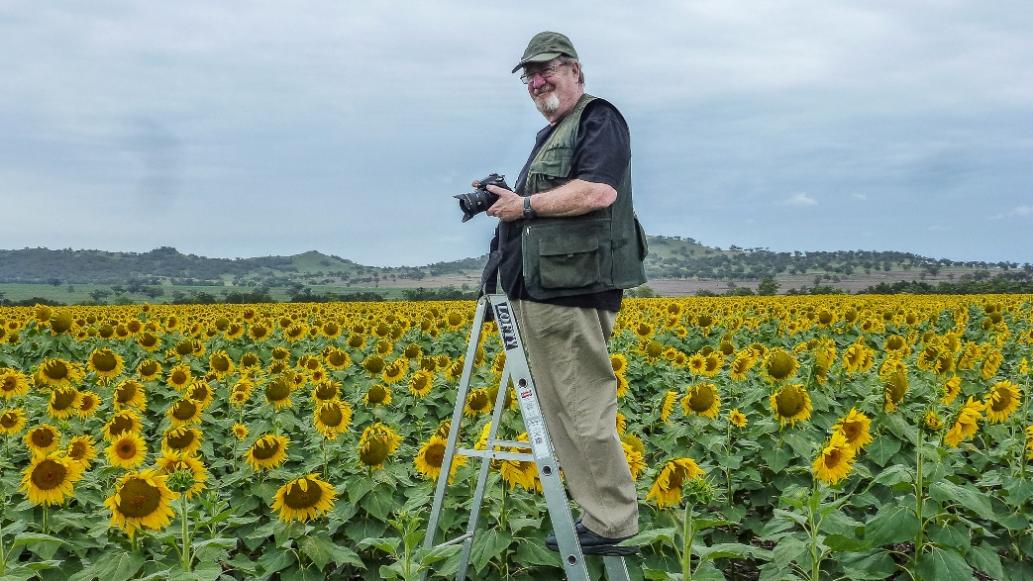
Notes
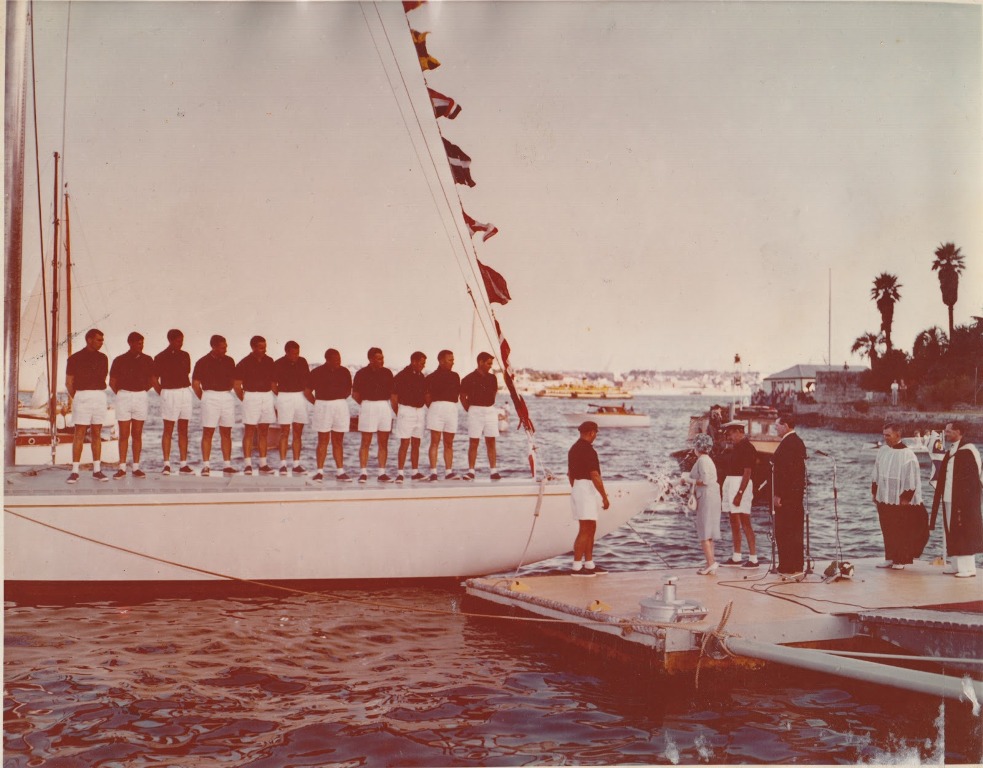
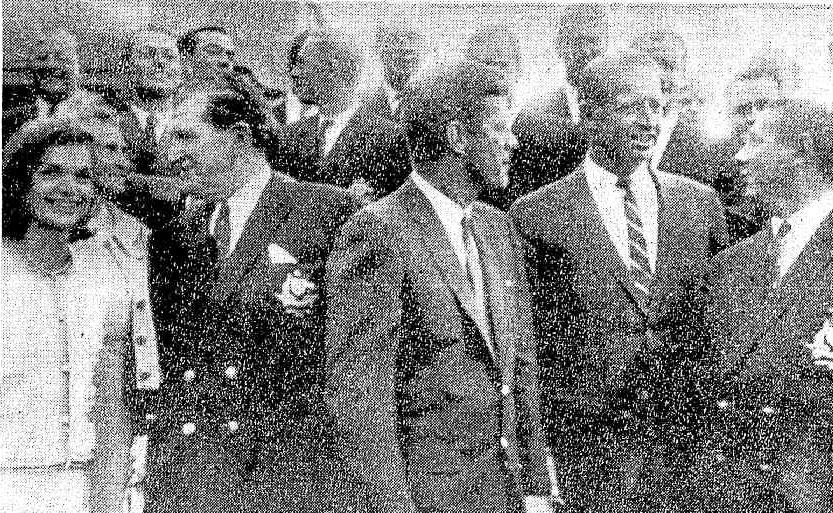
Gretel, as the first ever Australian 12 Metre, was launched on February 19th 1962 at the Royal Sydney Yacht Squadron on Sydney Harbour, seven months before the first Americas Cup Race. The boat was christened Gretel nine days later on February 28, 1962, in memory of Sir Frank Packer's late wife. Mr. Packer was President of the Challenge Association.

Gretel Launch - photo courtesy Old Sailing Blogspot
CHALLENGE YACHT TO SAIL AS GRETEL
SYDNEY, Wednesday.— Australia's yacht challenger for the America's Cup was officially named Gretel by Dame Pattie Menzics at the Royal Sydney Yacht Squadron to-day. Gretel was named after the late Lady Packer, wife of the Committee Chairman, Sir Frank Packer.
In a moving ceremony Gretel was blessed by R.A.N. Senior Chaplains G. P. Swain (Protestant), and Father G. S. Lake (Catholic). The Governor - General, Lord De L'Isle, and Lady De L'Isle attended the naming ceremony.
In a speech to 250 guests Dame Pattie said, "I name this ship Gretel.
"I commend all those who so faithfully and skillfully constructed her.
"May she uphold Australia's name overseas or wherever else she may represent.
"May God's protecting care be over all those who sail in her."
Dame Pattie made a presentation to the yacht of a clock "so that the crew can note the time the race was won," and a barometer "to see fair weather always ahead."
Lord De L'Isle presented a standard ship's bell on behalf of the Royal Sydney Yacht Squadron. Gretel later hoisted sail and cruised for 15 minutes off Kirribilli. CHALLENGE YACHT TO SAIL AS GRETEL (1962, March 1). The Canberra Times (ACT : 1926 - 1995), p. 32. Retrieved fromhttp://nla.gov.au/nla.news-article104924879

President and Mrs. Kennedy pictured with Sir Frank Packer (second left), head of the syndicate which built Gretel, the Australian challenger 1 in the forthcoming America's Cup yacht race, and skipper Alexander (Jock) Sturrock (right), and Emil (Bus) Mosbacher (second from right), skipper of Weatherly, the American yacht, at a reception for America's Cup crews given by Mr. and Mrs. Hugh D. Auchincloss, at Newport, Rhode Island.PRESIDENT MEETS CREWS (1962, September 15). The Canberra Times (ACT : 1926 - 1995), p. 1. Retrieved from http://nla.gov.au/nla.news-article131779725